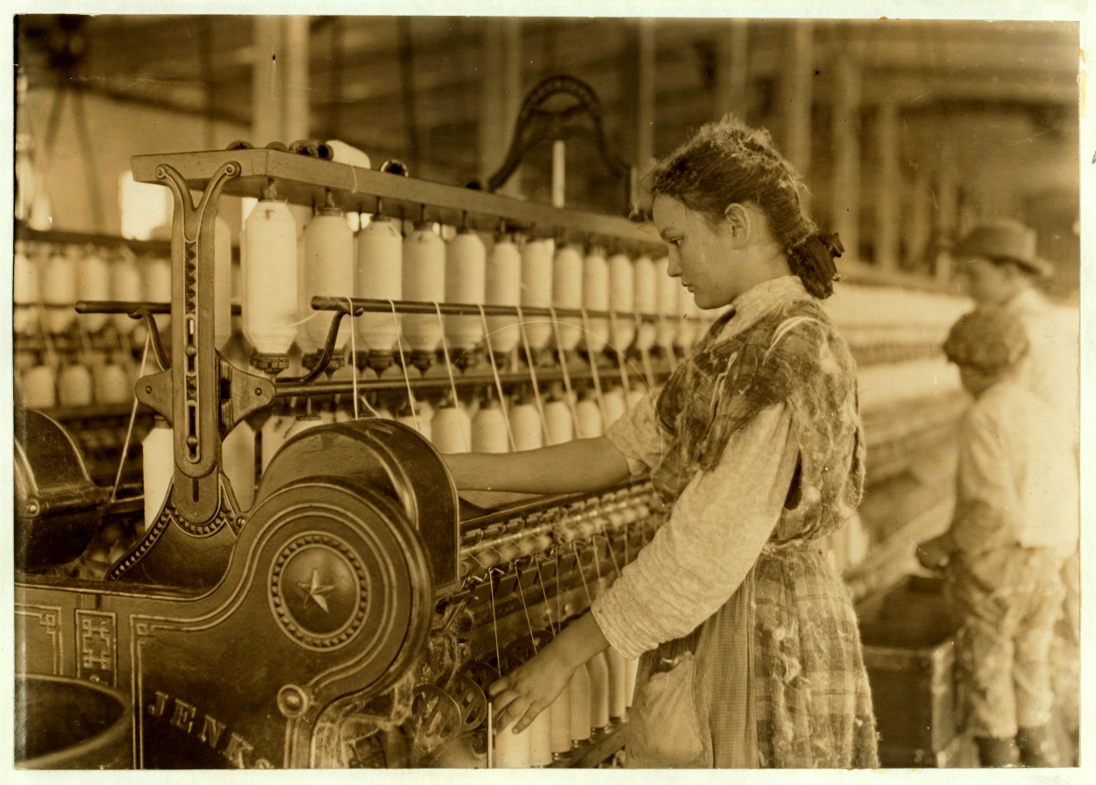Work in the Mills
PRIMARY SOURCE I--Photograph

- Title: Spinner in Vivian Cotton Mills, Cherryville, N.C. Been at it 2 years. Where will her good looks be in ten years?. Location: Cherryville, North Carolina.
- Creator(s): Hine, Lewis Wickes, 1874-1940 , photographer
- Date Created/Published: 1908 November.
- Medium: 1 photographic print.
- Reproduction Number: LC-DIG-nclc-01366 (color digital file from b&w original print) LC-USZ62-52642 (b&w film copy negative)
- Rights Advisory: No known restrictions on publication.
- Call Number: LOT 7479, v. 1, no. 0271 [P&P]
- Repository: Library of Congress Prints and Photographs Division Washington, D.C. 20540 USA http://hdl.loc.gov/loc.pnp/pp.print
- Notes:
- Title from NCLC caption card.
- Attribution to Hine based on provenance.
- In album: Mills.
- Hine no. 0271.
- General information about the Lewis Hine child labor photos is available at http://hdl.loc.gov/loc.pnp/pp.nclc
- Subjects:
- Girls.
- Textile mill workers.
- Textile machinery.
- Mills.
- Thread.
- United States--North Carolina--Cherryville.
- Format:
- Collections:
- Part of: Photographs from the records of the National Child Labor Committee (U.S.)
- Bookmark This Record:
http://www.loc.gov/pictures/item/ncl2004000858/PP/PRIMARY SOURCE II--Oral History
MM: Was it very dusty in the mill?
NORMAN: Yeah, it was pretty dusty in the cotton part. That creeling job was something on cotton until they put them fans that run around the track. That would blow the lint off of it. It was terrible until they put that up there. Out there in the cotton winding room, I don't know whether they ever did get anything. Now they did on the twisters, they had them blow things on the twisters that would run around the track. That kept the lint off of the yarn. But now the winding, they'd have to stop off about twice a day and clean up in the cotton winding room.
MM: Did people have trouble breathing sometimes?
NORMAN: I don't know. I never did work in the cotton winding room. The only cone winding I done was on them little Universal winders. But I did work on the cotton creeling. Them fans kept it blowed. The lint, and it wasn't too linty. When the mill was stopped off and we was changing the mill or creeling a mill on it was pretty linty. But when we started it up them fans would start blowing. Then the lint would all blow off.
Oral history interview with Icy Norman, April 6 and 30, 1979, in Burlington, North Carolina. The interview was conducted by Mary Murphy. Norman is describing a North Carolina cotton mill in the 1920s, about 20 years after the photograph was taken. http://docsouth.unc.edu/nc/norman/norman.html
SECONDARY SOURCE
Southern mill owners initially concentrated on producing coarse yarn and simple weaves because of the region's lack of skilled labor. Most Southerners had never seen a factory, much less worked in one. Mill owners used a family labor system that paid adults less than a living wage. So whole families — husbands, wives and children — labored in the mills to make ends meet.
Mill work was a wrenching change from farm life. In agriculture the family worked cooperatively to achieve a common goal. They worked hard, but they had more control over the pace of work. In the mills, families labored for bosses who drove them hard for 10 to 12 hours a day, six days a week. The factories were noisy, hot and dangerous. Lint floated in the air and collected on the hair and skin of the mill workers. After years of working in the mills many found that the lint had also settled in their lungs. The health problems that resulted could cripple or kill them. Workers who were injured on the job lost pay and sometimes they even lost their jobs.
excerpt from a library research guide on the Georgia State University website. http://research.library.gsu.edu/c.php?g=115684&p=751981